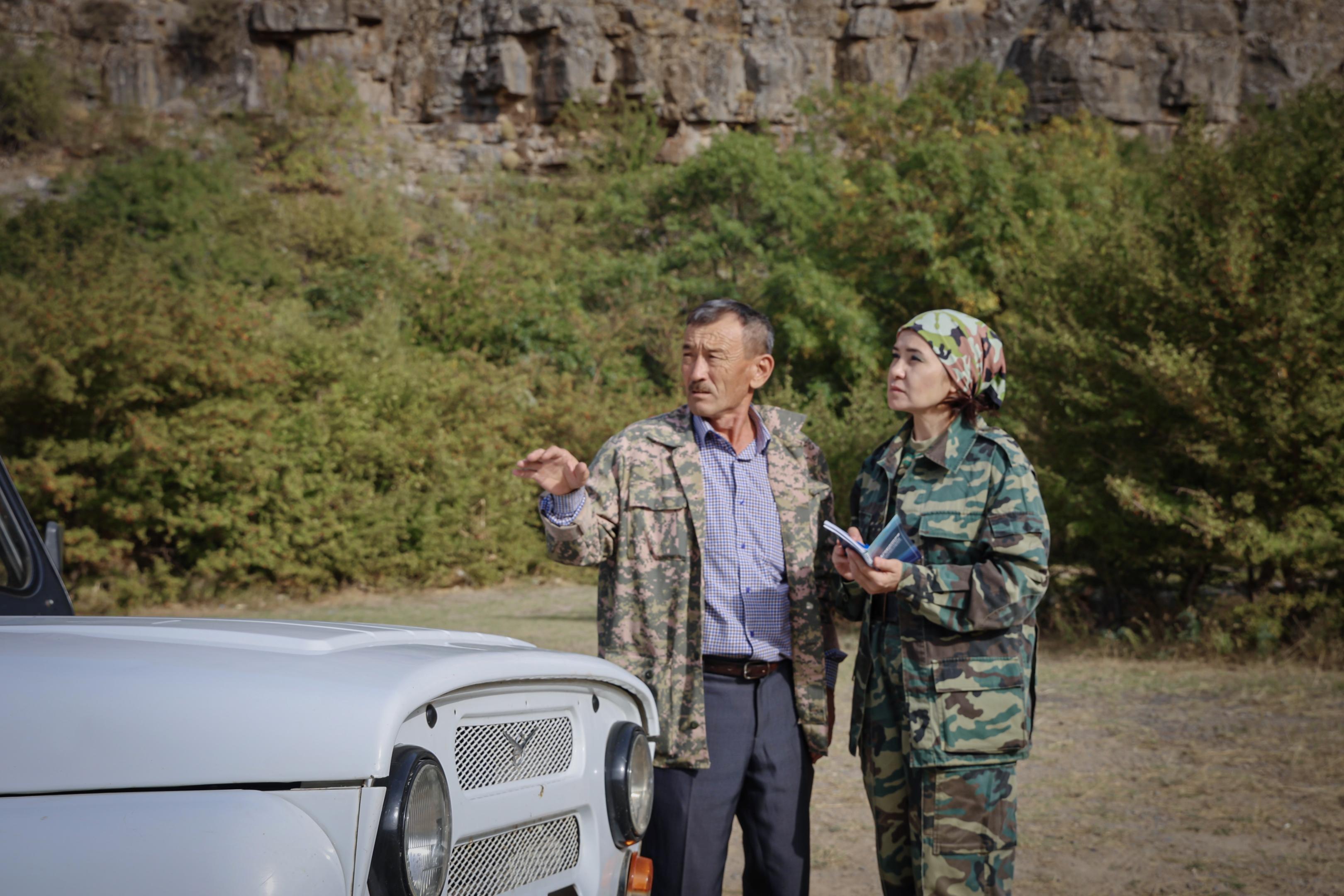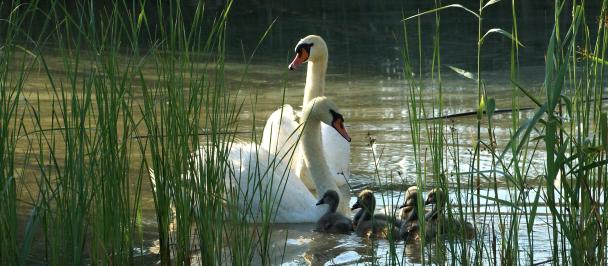South Kazakhstan is a treasure trove of endemic flora and fauna. It boasts a variety of natural landscapes – mountain ranges, steppes and semi-deserts– that stretch over many kilometres. Here, in the heart of the Karatau mountain ranges lies the Karatau Nature Reserve, a wildlife refuge, the youngest reserve in Kazakhstan created in 2004.
The Karatau Nature Reserve is the youngest reserve in Kazakhstan. Since 2016, it has been part of the UNESCO World Heritage Site.
Photo: Keregezhaygan Abdurassulova (1), Tamtobe Zhanatayev (2), Aitkulova (3), UNDP Kazakhstan/Ainura Salimbayeva (4)
The Karatau Nature Reserve is not as popular a wildlife destination in contrast to other natural areas of the country. Its primary importance is in the preservation of the biodiversity of the Karatau ridge and other adjacent landscapes. Scientists play an important role studying the little-known natural wildlife world of the Western Tien Shan. Luiza Abdurassulova, who discovered two rare species of butterflies to the world – Turanana luisa and Plebejus cambar – is one such talented female scientist.
Luiza Abdurassulova is scientist. Since 2004 she has been doing science in the Karatau reserve.
An early pioneer in the Karatau Reserve
Luiza has been working at the Karatau Reserve since its establishment. As head of the Department of Science, Information and Monitoring, she studies endemic rare species of flora and fauna, making important discoveries. All these years her passion for science has been supported by her family– her husband and three children.
Luiza's choice of profession is not accidental – her childhood dream led her to nature conservation. Born and raised in the small town of Kentau located at the foot of the Karatau Mountains, she knows the terrain of this region like the palm of her hand.
"I've known the nature of Karatau since childhood. We often spent our family vacations in the mountains. That's where my passion in learning about the flora and fauna was born," says Luiza.
After earning a master’s degree in ecology, Luiza started working at the new reserve as a senior researcher.
Since 2005, Luiza's main focus has been entomology, which she calls her “big passion”. Hence her interest in studying the biodiversity of invertebrates during the first scientific research expeditions in the Karatau reserve.
Luiza made her first scientific achievement, the discovery of two species of butterflies, under the guidance of Alexander Zhdanko, a leading lepidopterist at the Institute of Zoology. The butterflies were named after their discoverers, Luiza and Kambar Sambetov, the state inspector of the Karatau Nature Reserve, another participant of the expeditions.
Luiza studies an entomology and discovers new species of invertebrate in the reserve.
Nowadays, Luiza is involved in a roll-call of activities: this ranges from studying the biodiversity of invertebrates in the reserve, monitoring indicator species, assessing their abundance on the reserve, taking part in expeditions and conducting an inventory of entomofauna.
Delivering important results for biodiversity
Proud of her work, she notes the scientific research achievements pertaining to the reserve. over two decades, the science department she heads has delivered significant results for the biodiversity of Kazakhstan. Species of plants and invertebrates listed in the Red List of Kazakhstan have been discovered in the reserve and a number of endemic and relict specimens for Karatau discovered.

Luiza Abdurassulova with Maral Zhuztayev at the collection a data on wildlife in the Karatau reserve.
"In 20 years we attained impressive scientific results. Key achievements are the discovery of 9 new insect species in entomology, the identification of 40 endemic invertebrates, of which 20 species are endemic to Karatau. 136 insect species were identified for the first time in Karatau and 5 fauna species in southern Kazakhstan,"notes the scientist.
Thanks to all this research over two decades a positive trend in the conservation of rare species Karatau Reserve can be noted. Restoring the population of the endemic Karatau argali, a species on verge of extinction until the onset of the 21st century, is an important achievement. Bringing the argali back from the threat of extinction was the main reason for the Karatau Reserve's establishment. The argali is listed in the Red List of Kazakhstan and in the International Union for Conservation of Nature Red List as a rare and endangered species.
Karatau argali is an endemic, which is listed in the Red List of Kazakhstan and in the International Union for Conservation of Nature Red List as a rare and endangered species.
The unique importance of the Karatau Wildlife Reserve is recognized globally. Since 2016, it has been part of the UNESCOWorld Heritage Site. The reserve is relativelysmall and covers 34,400 hectares, so the questionof expandingits territory has been overdue for a long time. The rationale is further scientific research and the expansion of the Karatau argaliand otherwild animals' habitat.
UNDP, GoK and GEF initiative to almost double reserve size
The United Nations Development Programme (UNDP) in Kazakhstan has been actively working in this direction. Within the framework of the UNDP and the Government of Kazakhstan project, with Global Environment Facility funding, a scientific and technical paper was prepared justifying the expansion of the reserve area by almost half - to 56,400 hectares. This is the most important result for the conservation of rare species of flora and fauna of the Western Tien Shan.
Exploring the nature is Luiza’s calling, that she has been following for 20 years.
Luiza hopes that the expansion of the reserve area serve as an impetus for its development in the near future. The reserve has all the prerequisites for developing ecotourism, due to its proximity to the ancient city of Turkestan, in recent becoming one of the tourist centres of Kazakhstan. This vision requires creating an appropriate infrastructure: equipping hiking trails and routes and opening a visitor centre with information about flora and fauna.
Today, 44 employees work in the reserve. Speaking about the team, she notes that women in science make a huge contribution to the preservation of the country's biodiversity.
"Four women work in the reserve's science department,including myself. We are all experts in our field.I truly believe that women can work in the scientific field and protect nature on an equal basis with men. And we are a good example", Luiza says.

Akbota Assylbekova, a botanical scientist works with Luiza in Karatau reserve.
More funding badly needed to develop nature reserves and national parks
Noting the important achievements of her colleagues in science and environmental protection, Luiza is forthright about the most pressing problems in the system of protected natural areas in Kazakhstan: the acute shortage of qualified specialists and scientific personnel and low wages. These factors directly affect the lack of interest of young specialists in science and the environmental sector, which negatively impacts the development of nature reserves and national parks in the country.
The lack of additional funding is one of the factors that is "slowing down" the development of science in protected areas, Luiza notes. Reversing this trend would allow the of hiring highly qualified specialists from research institutes.
"The connection between the environmental sector and science is very important, therefore it must be maintained and developed. Working with specialists and scientists from scientific institutes helps to improve the quality of wildlife research. However, scientific organizations work directly within the framework of grant projects, so the underfunding of scientific work in protected areas is an urgent problem," she notes.
Despite such difficulties, Luiza loves her work in the reserve, calling it "my life's labour". Living in nature allows her to combine work with leisure thereby inspiring Luiza to make new scientific discoveries for the benefit of future generations.
Since 2004, thanks to research in the Karatau Reserve, 1,342 species of invertebrate species have been identified, with 16 listed in the Red Book of Kazakhstan. Among the plants, 1,221 species have been identified, with 59 listed in the latest edition of the Red Book, of Kazakhstan, of which 131 species are endemic, 85 species are ancient relics. The list of vertebrates includes 21 species, of which 3 species are listed in the Red Book of the Republic of Kazakhstan: Karatau argali, Indian porcupine and stone marten. The avifauna includes 126 species of birds. The rare and endangered birds included in the Red Book of the Republic of Kazakhstan include 12 species. The ichthyofauna of the reserve is represented by 5 species. Amphibians - 2 species, of which Pevtsov's toad is listed in the Red Book and reptiles comprise 10 species, of which one is listed in the Red Book of Kazakhstan.

 Locations
Locations




